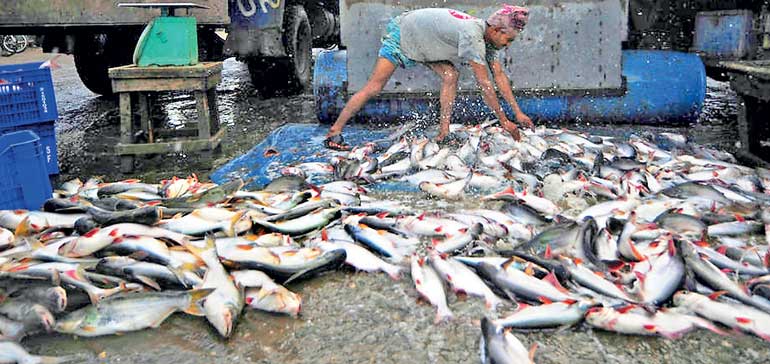Friday Jan 02, 2026
Friday Jan 02, 2026
Tuesday, 12 April 2022 03:55 - - {{hitsCtrl.values.hits}}

By Sandesh Jayasinghe
The Fifth Assessment Report of the United Nations Intergovernmental Panel on Climate Change (IPCC) reset the climate expectations going forward with an analysis of the continued deterioration of the environment and its long-term impacts.
It painted a negative future for the fisheries industry with uneven rainfall and rising temperatures expected to reduce production.
The report states that: “Asian fisheries and aquaculture, including the local communities depending on them for livelihoods, are highly vulnerable to the impacts of climate change”. It pointed to the increase in sea level and the decrease in precipitation in some parts alongside the increase in temperature to become problematic going forward.
In regard to the impact on local communities, it states: “Coastal fishing communities are exposed to disasters, which are predicted to increase. Fisheries in most of South Asia and Southeast Asian countries involve small-scale fishers who are more vulnerable to climate change impacts compared to commercial fishers.”
According to the report, 44% of coastal communities’ GDP comes from fisheries in Sri Lanka.
In regard to the reduction in overall production, it states that: “About 69% of the commercially important species of the Indian marine fisheries were found to be impacted by climate change and other anthropogenic factors.”
Since there is a correspondence between Indian fisheries around the Bay of Bengal and Sri Lankan fisheries a similar if the not slightly altered outcome can be expected.
In regard to alternative methods like shrimp farming, the report clarifies some of the concerns Sri Lankan fishermen have faced in the recent past confirming that the “Majority of the shrimp farmers also observed that weather has changed abruptly during the last five years and that high temperature is most detrimental, lowers growth rate, increases susceptibility to diseases including deformation and affect production.”
Even seaweed farming which only takes place on a relatively small scale in Mannar, Killinochchi, Nainathivu, and Karenagar will face the direct impact of climate change. Despite its ability to capture carbon and have a net positive impact as part of the blue economy strategy, it will be susceptible to climate change as well.
Aquaculture is a promising avenue for growth in the fisheries industry with a notable upwards tick the stated in the 2020 Annual report during a down year for fisheries. The report claims to have caution when proceeding with the practice and points to the long-term unsustainability of the industry.
“Marine heatwave (MHW) is a new threat to fisheries and aquaculture including disease spread, live feed culture, and farming of finfishes like Cobia. Predicting MHW is considered a prerequisite for increasing the preparedness of farmers.
“In Southeast Asian countries more than 30% of aquaculture areas are predicted to become unsuitable for production by 2050 - 2070 and aquaculture production is predicted to reduce by 10% - 20% by 2050 - 2070 due to climate change by 2050 and 9% by 2100.”
As per the 2020 Annual report, fisheries reduced by Rs. 113 billion to Rs. 94.5 billion with a reduction from 1.1% to 1% of the total GDP.
Growth showed a negative decline of 4% to 16.6%. Alongside those exports saw a further 29.5% decline as a result of lower demand from key export destinations and the disturbances to global logistics.
The long-term projections for climate change on the economy place the massive economic cost at about 6.6% of the GDP in Sri Lanka from 30 sectors, including agriculture, water, coastal, marine, health, and energy most vulnerable to climate change.